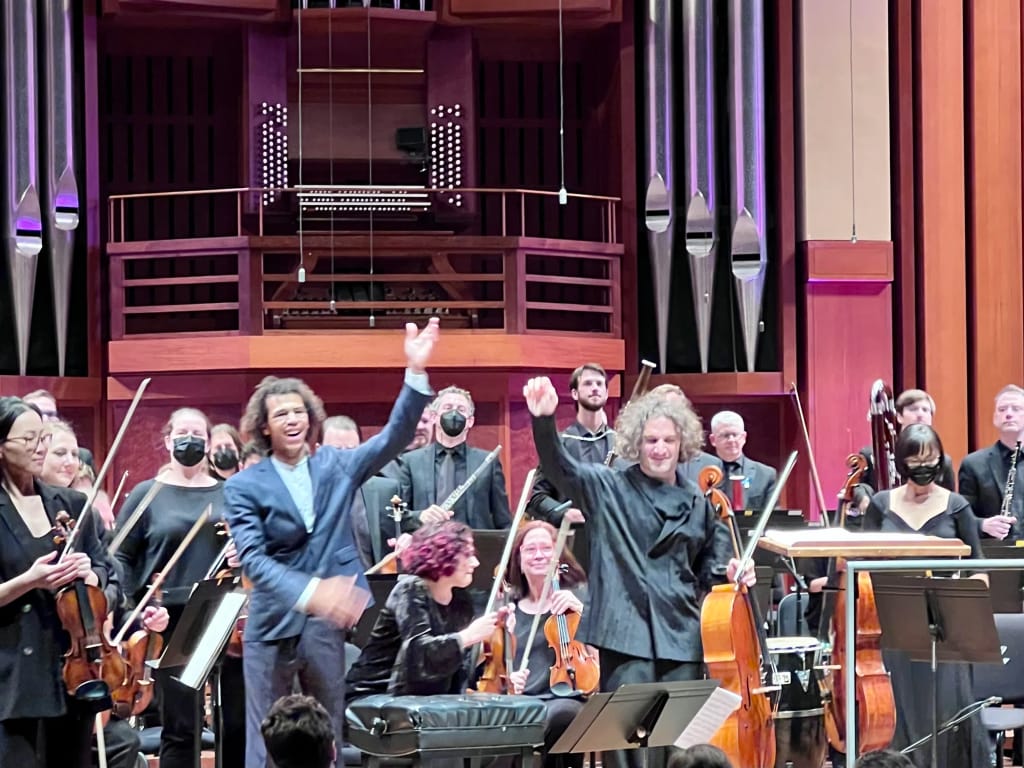- Gathering Note
- Posts
- Heyward returns to the Seattle Symphony with impressive performances of Dvorak and Salonen’s Cello Concerto
Heyward returns to the Seattle Symphony with impressive performances of Dvorak and Salonen’s Cello Concerto

Originally published at Seen and Heard International
The most recent Seattle Symphony concert was once envisioned as a matchmaking session between a rising maestro in Jonathon Heyward and an orchestra in search of a new leader. In 2019, Heyward had made an impressive debut with the SSO. With youth on his side, a resume of lauded concerts, and a taste for interesting repertoire, rumors swirled that Heyward could be a good fit. But after Heyward’s return to Seattle had been planned, the Baltimore Symphony announced that he would succeed Marin Alsop as its music director.
That may have changed the calculus behind Heyward’s return to the podium, but not its tone or temper. As with his debut program with the Seattle Symphony — which blended Haydn and Holst with a new work by Hannah Kendall — Heyward mixed the familiar with the novel. The latter in this case took the form of Esa-Pekka Salonen’s Cello Concerto, performed with aplomb by German cellist Nicolas Altstaedt. Salonen’s enigmatic description of the piece contrasts sharply with experiencing it live in concert, where energy radiates off the stage and fills the performance hall. Set in three movements, the structure is familiar enough, but belies a special intricacy that must be heard to be believed. An energetic opening movement precedes an introspective middle section that is rich with melodic lines for both the solo cello and flute accompaniment. The fast-paced final movement is more reminiscent of many of the standards in the cello concerto repertoire.
The work oozes with Salonen’s distinctive musical mode of expression, which seems to draw heavily from the opulence of the late Romantic tradition. And yet, the concerto is a modern composition, with modern sensibilities. The most apparent of these flourishes is Salonen’s careful deployment of recorded bits of music during the performance. In the second movement, short fragments played by Altstaedt were recorded ahead of time and broadcast on cue through speakers at the front of the stage. The effect is mesmerizing, creating overlapping waves of sound that give the impression of multiple cellists playing at once. These and other dramatic features imbue this work with curiosity and personality, and will hopefully ensure that it will be no stranger to performance halls around the globe.
The bookends of this concert were Smetana’s Moldau and Dvorak’s Symphony №7. Both pieces were finely shaped, with immaculately crafted phrasing. Heyward’s attentive care boosted the orchestra’s inner voices without sacrificing its heft — coaxing out an appealing, glowing sonority. In fact, in the days that have followed since the performance, I can’t remember a time when the orchestra has sounded so three dimensional. In recent years, the Seattle Symphony has vacillated between performances seething either with intensity or cool, analytical precision. Heyward’s skill at the podium served as a welcome reminder that nuance and energy are possible with the right music director. If Heyward’s lacked anything, it was momentum. Smetana’s work evokes a flowing river, while Dvorak’s 7th — arguably his most “Brahmsian” symphony — propels forward with Czech energy. With no rhythmic vitality, Heyward’s vision for these works bogged down in execution. But Heyward is young enough that his conception of masterpieces will no doubt evolve with time.
The SSO’s season is off to a strong start with the help of strong musical partners like Heyward. Soon he’ll be off to the Baltimore Symphony where new adventures await. Audiences there will get to appreciate how his interpretations evolve and develop. In the meantime, I hope the Seattle Symphony brings him back for future engagements, regardless of who permanently takes up the post at Benaroya Hall.